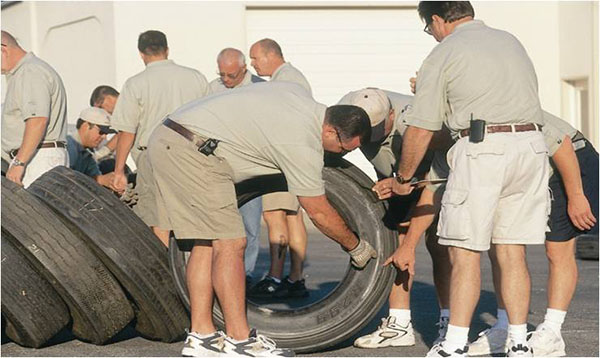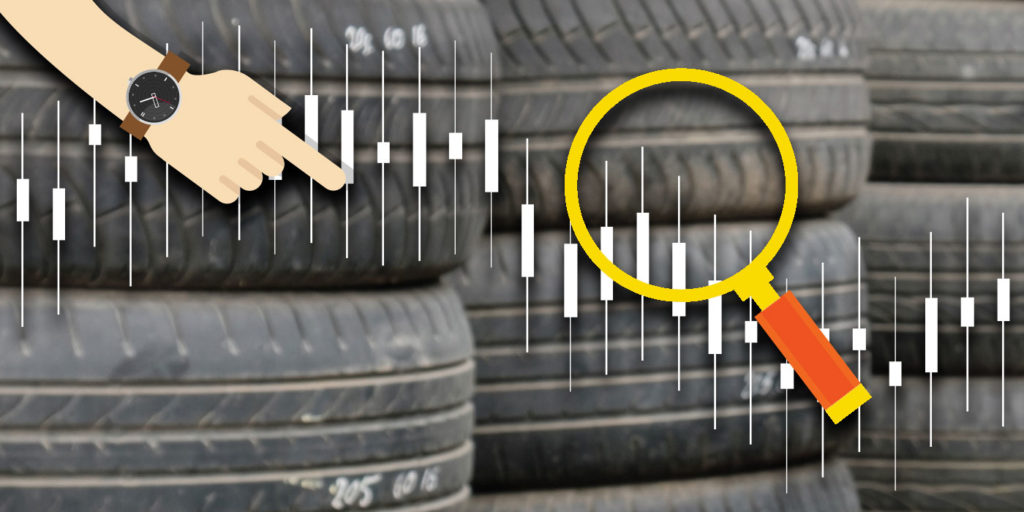See the rising sun behind the peaks of that pile of rubber? There’s gold in them there black hills, fleet managers. Gold in the form of information–a tale of your tire operations, maintenance and pressure management practices. So don some protective gloves and let’s start grabbing some scrap tire rubber out of the pile to see what it has to say.
Our guides on this adventure are a number of the truck tire industry’s top minds. Like the unique out-of-service causes that you’ll likely see from the scrap, I’ve picked their top scrap tire analysis talking points out from our tire maintenance conversations that have ranged from proper tire pressure management to the most commonly overlooked tire maintenance practices (go ahead and click those links to explore those stories).
Here’s what they had to say.
That’s a big pile, where do I start?
“It’s not possible to focus on everything at once, so I always encourage fleets to focus on the top one or two removal causes. I’ve been in scrap-out sessions where the bulk of the time was spent on a handful of unusual tires. The unusual tires can be interesting, but understanding those removal causes is not likely to improve a fleet’s overall tire costs.”
–Pat Keating, senior manager of field engineering, Yokohama Tire
Determining operational performance issues and causes of out-of-service issues
“Operational performance results might include curbing, design, driver-induced or load distribution. Whereas out-of-service issues would include poor retreading, failed repairs, etc. It is an important step to analyze the history of scrap tires and evaluate and determine the type of tire damage, the vehicles on which the tires were operating, as well as the areas they operate. If there is a lot of damage, it is crucial to determine the source of the damage. Key to the evaluation is tire manufacturer, tire design, tire size, ply rating, age, number of retreads, casing condition, tread depth, load distribution and alignment. If the problem is accurately diagnosed, changes and new practices can be implemented to correct the issue.”
–Lawrence Williamson, B2B regional technical partner and customer engineering support manager, Michelin North America Inc.
Getting a good bead on it
“Bead appearance is a good indicator of under-inflation, overload, brake heat, etc. That is: How much is the bead area deformed? How hard is that bead face rubber? Is it brittle?”
–John Grimm, manager of field engineering, Falken Commercial Division

Treading trends
“A best practice is for fleets to first examine the existing tread on a tire to see if there is any unused tread, which correlates to a loss of value for the casing. This can help assign a lost dollar amount to the tire, which was not able achieve its full life cycle. Fleets should also capture information about the tire such as application, tire size, manufacturer, type of tire and the DOT manufacturing code to determine the age of the tire. Knowing the number of times a tire has been retreaded and which vehicle the tire came from can also help identify potential operational performance issues or driver and environmental patterns.”
–Matt Schnedler, product manager, truck and bus radial, U.S. and Canada, Bridgestone Americas Tire Operations.
What are you actually pulling out of the pile?
“There are four questions I ask when looking at every scrap pile: 1. Can it be returned to service? If there’s a tire out of service because of irregular wear, it could possibly be returned to service in a regional or trailer application. 2. Can it be retreaded? It’s not necessarily scrap if it can be retreaded–maybe not for you because you have a tight retread specification, but a retreader might be able to retread that for a different application. 3. Do you have money coming your way? This is a warranty opportunity from a new tire manufacturer, retreader or a service provider that did a failed repair. And 4. Can you learn anything? Which is the point of going through scrap.”
–Jason Miller, national fleet channel sales manager, Cooper Tire and Rubber Co.
Go back to the beginning of tire management
It starts with the right tire pressure. Our panel of pros had plenty of helpful tips for that, which we collected in our tire pressure management story—click here to read it. Then you can follow the tire into the service process and ensure your techs are not falling victim to the most overlooked tire maintenance practice. Click here to find out—the answer may surprise you.














